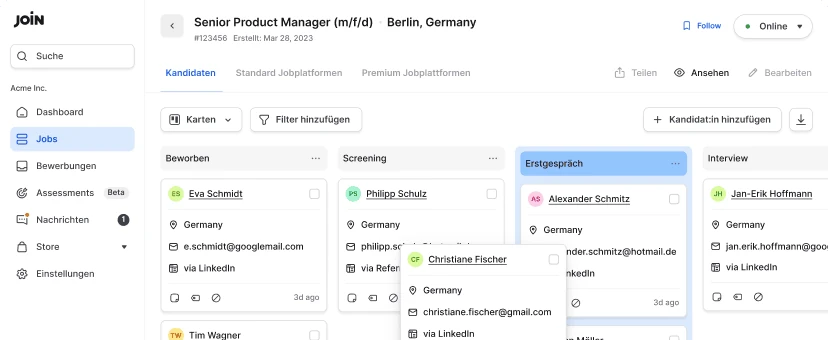Sourcing passive candidates in 8 unique ways [how to]
You might already know where to find candidates who are actively looking for a job. Unemployed professionals desperate for a job or employees from other companies looking to take a next career step.
Table of contents
- What is passive candidate sourcing?
- How to source passive candidates in 8 unique ways
- Additional tips on how to recruit passive candidates
- Sourcing passive candidates starts with you
What is passive candidate sourcing?
You might already know what talent sourcing means. But if not, be sure to check out this article first: What is candidate sourcing? Definition and meaning. Now, the candidates that you can try to source for your company can be divided into two different groups:- Active candidates
- Passive candidates
The ease of active
The first type, active candidates, are actively looking for a job. They are typically not employed, yet want to be, or they are employed but looking for a new opportunity and the next step in their career. That’s why they’re browsing through job boards, sharing their “open to work” status on LinkedIn, or asking their network for help. Targeting active job seekers can be a rather low-effort, hands-off sourcing method. Often, a company creates a job advertisement, publishes it to one or more job boards (multiposting), and then simply wait till they’ve received enough applications to move on to the interview process. Especially when using a multiposting tool and/or applicant tracking system (ATS) – like JOIN’s free recruitment software – this process only takes a few clicks. Because the candidates are actively searching, you can sit back (relatively) passively as the sourcing almost does itself. Of course, you might want to allocate budget to promote your job ad to get it in front of the right people more quickly and effiecently. But when sourcing active candidates, youre still trusting that applicants will ultimately take the initiative and apply to your job opening without further help from your side.The challenge of passive
Contrary to their active counterparts, passive candidates are currently not actively searching for a job. In most cases, they are either already employed elsewhere or unemployed but not looking for work. Of course, that doesn’t mean they can’t be the perfect professional to fit your job opening. But as they’re not looking for a new job themselves, it means you have to find ways to reach them yourself. And that pro-active approach to recruiting candidates is what’s called passive candidate sourcing. It’s the strategic recruitment approach focused on identifying and engaging individuals who are not actively seeking a new job but have the skills, experience, or attributes that would make them a valuable addition to your organisation. But why bother if you can save time and effort by just focusing on active candidates? Well, because studies estimate that over 70% of potential candidates are passive candidates. Which means you’re only reaching (and thus potentially recruiting) around 30% of all those possible qualified candidates. Are you getting enough applications and you’re happy with the talent you’re attracting? Then maybe you don’t need to further widen your talent pool by actively looking for passive candidates. Instead, stick to using the best job boards or leverage the power of talent acquisition software (like JOIN, it’s free!) to easily reach that top active talent. Do you want even more qualified candidates to discuss opportunities with? Then keep reading! Below, you’ll find a step-by-step guide on how to source passive candidates. Following these strategies, you’ll be able to successfully dive into this often untapped talent pool. Let’s go!How to source passive candidates in 8 unique ways
Passive candidate sourcing requires a strategic approach to identify and engage with individuals who may not be actively looking for a new job. Here are some effective methods to find and recruit passive talent.1. Browse professional networking sites
Probably the most common place where hiring managers look for passive job seekers is LinkedIn. This, and other professional networking platforms like XING, are great places to find and connect with potential passive talent. Easy sourcing strategies to try here include simply searching for the job title you’re hiring for and connecting to people that show up in the search, or looking through competitor pages to find employees to reach out to. Bear in mind, though, that cold outreach like this has a high rejection rate. This means you might have to reach out to many potential candidates before getting a reply. This can quickly become a time-consuming process, which means you might want to consider hiring a recruiter.2. Take to social media
One of the most powerful ways to find passive candidates is through social media platforms. Twitter and Facebook (and Meta’s new app Threads), with their billions of users, offer great opportunities for recruiting passive candidates. Use Twitter’s advanced search feature to find relevant hashtags related to the role you’re hiring for. For example, if you’re looking for a content manager, search for hashtags like #contentmarketing or #SEO. Follow individuals who share valuable insights or answer industry-related questions. Participating in Twitter chats can also help you connect with professionals in your field. Similarly, Facebook’s search can help you find people who match specific criteria. For example, you can search for “salespeople who have studied in Amsterdam” to find a potential passive candidate. Also, while additional social platforms like Instagram, Reddit, and Snapchat may not be as popular for recruiting as LinkedIn or XING, nor as Facebook or Twitter, they do still offer opportunities with less competition. Take advantage of these platforms by searching for discussions or subreddits related to your industry. Engage with individuals who demonstrate knowledge and interest in your field. However, remember to be cautious and avoid aggressive recruiting tactics, as users on these platforms may not appreciate it.3. Check out portfolio and work sample sites
Online portfolio sites like Behance and Dribble are excellent resources for sourcing creative professionals such as designers. These platforms allow you to view candidates’ work and assess their skills. For developers, platforms like GitHub, Codility, Devskiller, and HackerRank provide insight into their coding abilities through team or individual projects. Hosting coding challenges on these platforms can help you identify top candidates based on their performance.4. Attend conferences and industry events
Despite the prevalence of online networking, meeting passive candidates in person can still be highly effective. Face-to-face interactions allow you to build trust and establish rapport. For example, you can attend conferences and events. These provide excellent opportunities to meet and network with professionals in your industry. Platforms like meetup.com and eventbrite.com can help you find relevant events and identify potential attendees. You can also look for the most best conferences in your field that you could attend. Additionally, consider hosting your own events to attract passive candidates and showcase your organisation.5. Hackathons, career fairs, and campus events
Hackathons, career fairs, and campus events are great venues for connecting with talented individuals who may not be actively seeking job opportunities. These events attract motivated and skilled candidates who are eager to showcase their abilities. Engage with participants, learn about their current roles, and explore their interest in new opportunities. Remember to focus on their aspirations and determine if your organisation can offer a job that aligns with their career goals.Suggested read: How to run a hackathon at your company
6. Through connections and employee referral programs
Employee referrals and trusted connections can be a valuable source of passive candidates. Referred candidates often have higher productivity and lower turnover rates. Encourage your colleagues to refer potential candidates by sending specific emails detailing the role you’re sourcing for and the key requirements. Consider implementing a referral program with incentives to motivate employees to refer qualified candidates. Additionally, leverage your own network by reconnecting with previous coworkers or fellow alumni who may have knowledge of the profession you’re sourcing for.7. Through past hiring processes
Rejected candidates from previous hiring processes can be an excellent source of passive candidates as well. If you have a candidate database or an applicant tracking system (ATS), you already have access to a pool of potential candidates. Review their profiles, taking note of any improvements or career advancements they may have made since their initial application. Candidates who had a positive experience with your company are more likely to consider future opportunities. Reach out to these candidates, highlighting any relevant updates or changes in your organization.
8. Through tools and services
In addition to manual sourcing methods, various tools and services can streamline the process of finding passive candidates. Platforms like Monster’s Talentbin or Careerbuilder’s resume database provide access to extensive resume databases. These platforms often offer advanced search capabilities and can help you identify candidates who meet your specific requirements. Professional sourcing services can also assist when time is limited or when you need additional expertise in sourcing passive candidates.Additional tips on how to recruit passive candidates
Once you have identified passive candidates, it’s time to recruit them for your organisation. Here are some further strategies to effectively recruit passive candidates.Approach passive candidates carefully
When reaching out to passive candidates, approach them with honesty and simplicity. Introduce yourself and establish a connection before sending any recruitment messages. Participating in industry-related forums and discussions can help you build credibility and familiarity with potential candidates. Avoid being pushy or spammy; instead, maintain a polite and respectful tone. If you don’t receive a response initially, follow up a few times with well-crafted messages.Send personalised sourcing emails
Personalised sourcing emails are essential when recruiting passive candidates. Generic, bulk emails are unlikely to capture their attention. Take the time to craft personalized messages that highlight specific accomplishments or skills that caught your attention. Keep the emails concise and focus on the candidate’s interests and aspirations. Research their online activities and mention any relevant certificates or projects they have shared. By showing genuine interest, you can increase the likelihood of engaging passive candidates in meaningful conversations.Communicate what passive candidates want to know
Passive candidates are often curious about company culture, values, and perks. When communicating with them, provide honest insights into your organization and what sets it apart. Share information about office locations, benefits, and career growth opportunities. Passive candidates appreciate transparency and value employee opinions. Be prepared to answer questions about job expectations, workload, and the potential impact of a new role on their career progression.Sourcing passive candidates starts with you
Sourcing passive candidates requires a strategic and targeted approach. And you have to be the one to pro-actively drive it. By utilising online platforms, attending events, leveraging connections, and employing effective screening and recruitment methods, you can identify and engage with top talent who may not be actively seeking job opportunities. Remember to personalise your approach, communicate what candidates want to know, and provide a positive candidate experience throughout the process. With these strategies in place, you can successfully attract and recruit passive candidates to enhance your organization’s talent pool and drive growth. Need more help? Then check out these additional resources:Frans Lelivelt
Frans is JOIN's multilingual Senior Content Manager. His main topic of interest in the recruitment space is DEI and how companies can reduce their (unconscious) biases to make the world of work a fairer, kinder place for everyone. Outside of work, he tries to do the same for animals, spending much of his spare time in the kitchen preparing plant-based feasts.




